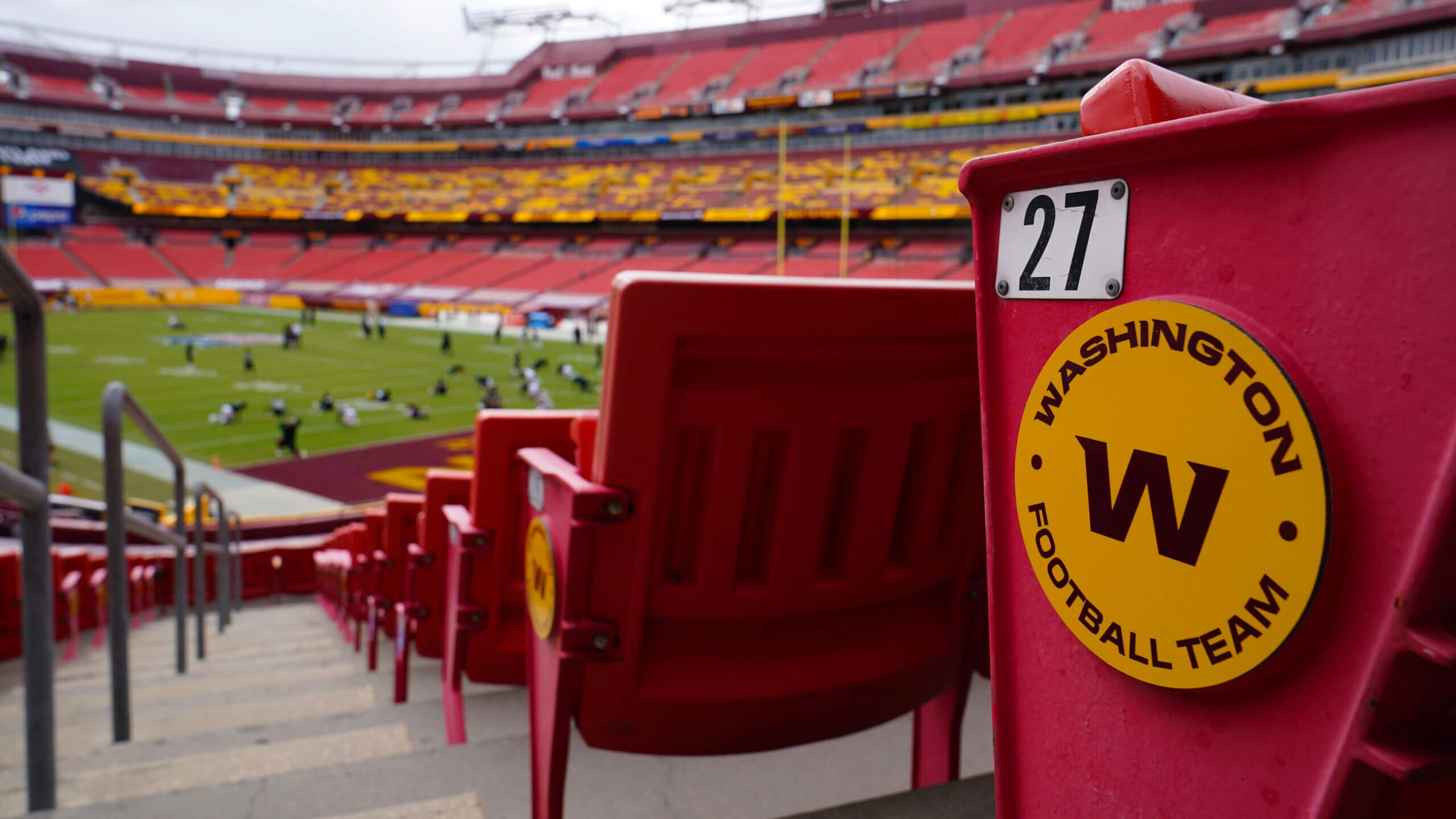
When the Washington Football Team decided last summer to retire its longstanding team name, there was a lot of talk about how shareholders and investment firms had pressured the team to make the identity change. But what does that mean, exactly? Who were these shareholders and investment firms, and what sort of pressure were they applying?
I recently had the opportunity to interview Steven Heim, managing director at Boston Common Asset Management, an investment firm that specializes in ESG issues. Heim and his company were instrumental in drafting the letters that were sent last summer to FedEx, Nike, and PepsiCo, asking the companies to sever their ties with the Washington team unless it changed its name.
Those letters began the chain of events that resulted, just a few days later, in the team deciding to change its identity. But as Heim explained to me in our interview, those letters were actually the culmination of a decades-long process. Here’s an edited transcript of our discussion.

Uni Watch: Please tell me a little bit about Boston Common Asset Management — what it is and what you do for them.
Steven Heim [shown at right]: So we’re an investment management company, and we’re a global money manager. We invest in companies in the United States and in other countries. Our specialty is actually in the international area, as far as international stocks. And we focus on sustainable, responsible ESG investing — we’ve done that since we started in 2003. At present, we’re around $4 billion in assets under management.
Also, part of what we’ve been doing from the beginning is shareholder advocacy or engagement with companies, and also policymakers, to advocate for better practices on the environment, human rights, labor practices, product safety. Also, climate change is a big issue. And then my job has been on overseeing our environmental social governance research, which I’ve been doing since we started in 2003. I’ve also helped out in our shareholder advocacy or engagement program, where I actually meet with companies and organize coalitions of investors and then also work to try to bring up the things they can do to improve their practices. So I’ve been doing that also since 2003. And my overall experience in the in the field has been about 30 years now working in the sustainable investing area.
UW: When and how did you get interested in the issue of Native American iconography in sports? And how did you decide to use your position at Boston Common to essentially create your own form of activism in that area?
SH: At Boston Common’s predecessor company, we were looking at a small cap stock, Applebee’s restaurants. Part of the decor package was the wooden cigar store Indian, or just a dummy statue. We found out that this was a problem area for the company and reached out to the American Indian Movement chapters in Florida and some other areas. Then we wrote a letter to Applebee’s raising issues about the use of that statue in their restaurants, and the company actually responded and saying, “Thank you very much, we’re going to remove that from our decor packages.” That was in 1998 or so.
And then we later established what was first called the Indigenous Peoples Task Force, which was part of the U.S. Social Investment Forum, and I was the chair of the advocacy committee. One of our original topic areas was racist imagery and cultural appropriation of Native Americans.
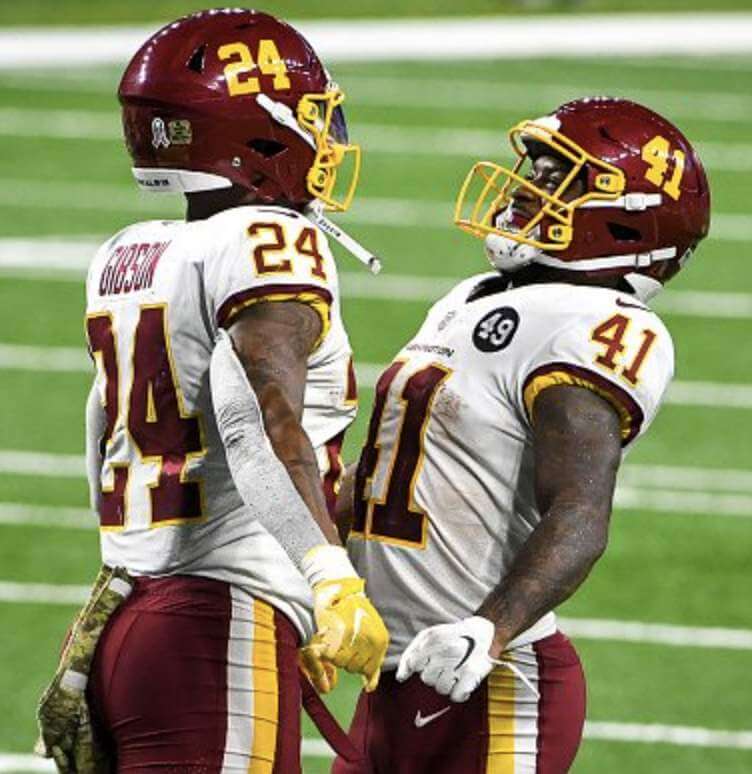
On this topic [the Washington NFL team], our first discussions were in the fall of 2007, when Gary Brouse, who worked for a group called the Interfaith Center on Corporate Responsibility — he’s Native American, and done quite a bit with all sorts of different issues and brands and also sports teams — said this is an issue we should have our group work on. And that was with the issue of FedEx being the corporate sponsor of the Washington team. And that’s how we actually started, back in November of 2007.
UW: It was widely reported last summer that shareholders and investment firms like yours were urging FedEx and Nike and PepsiCo to sever their ties with the team. What does that actually mean? We hear these terms — investors and investment firms are “pressuring.” What does that mean in a boots-on-the-ground sort of way? What was actually taking place, and what specifically was your role in all that?
SH: Our investor group, which had been working on these issues since 2007, sent letters to each of the three companies and laid out what the issues were and why they needed to change what they were doing. We noted some other companies that were making changes to some of their marketing practices. And so even though it was just those three letters, which were dated around June 27, that represented more than a decade of investor work, particularly with FedEx. And I made a quick tally of 140 calls that we had with FedEx where this was on the agenda — “Washington, DC football team” was on the agenda. So we’d been working on that for years and years.
In my own work on the issue, particularly with FedEx, I made a rough estimate of the number of documents on my computer and it was over 500 documents related to this particular issue. So even though we — Boston Common — weren’t investors in FedEx after the first year or two, it was an important issue for us to lead and help organize investors on.
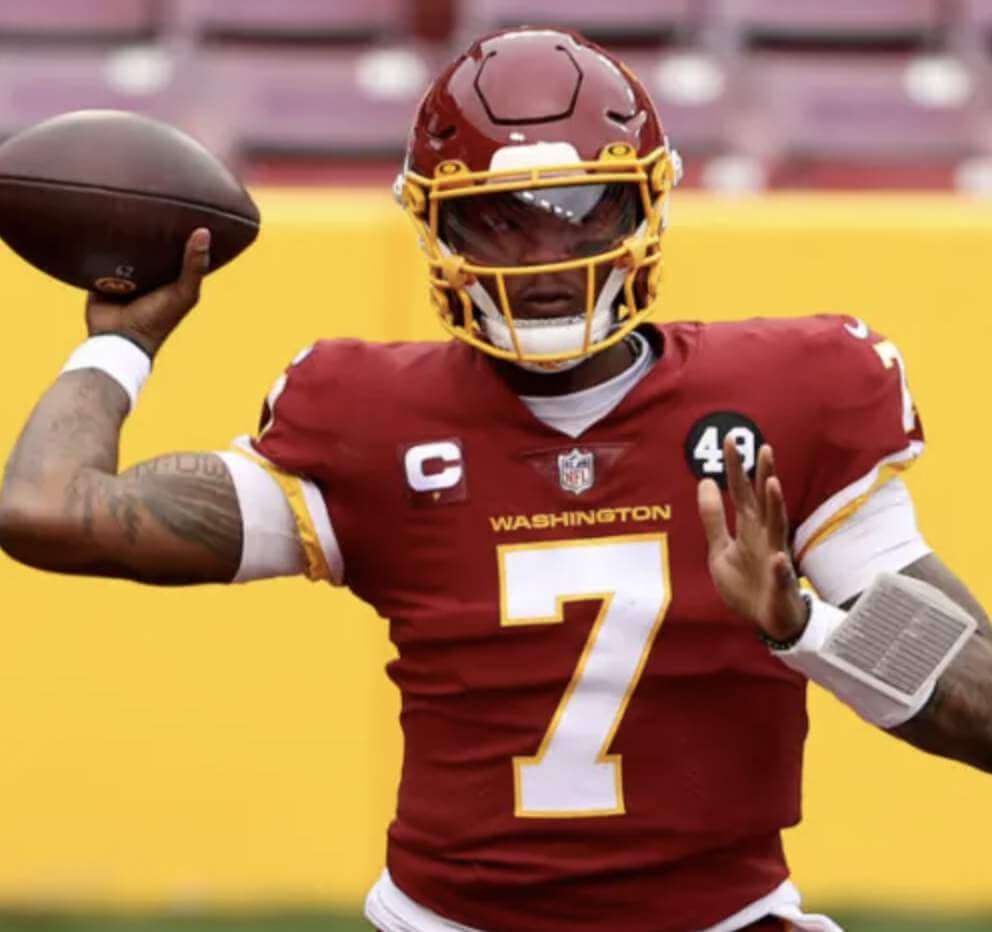
UW: So are you saying that those three letters were the culmination of all this groundwork you’d been laying for years?
SH: For Pepsi, it was really the first letter. And Nike, there were discussions with staff at conferences, and we were getting shareholder proposals ready to send to the company. But with FedEx, there were multiple letters, petitions to the board of directors where eventually we had over 100 organizations sign onto it, about 33 of them being Native American organizations. Going to their [FedEx’s] annual meeting, Susan White of the Oneida was the leader on that. She went to several their annual meetings, and we had a meeting with a lot of their executives in Memphis back in 2009. So with FedEx, it was multiple phone calls, meetings, letters, petitions to the board, shareholder proposals. We tried multiple tactics, year after year. As investors, we can go to the corporations and raise these issues, plus bring it to the larger shareholders, and that’s what we tried with FedEx, but they kept successfully getting it off the proxy statement to actually have a vote.
UW: In these letters and proposals and meetings, what sort of case are you trying to make? Are you trying to make a moral case, a financial case, an ethical case? What is the leverage you’re trying to apply?
SH: Our leverage as investors was just the harm to FedEx’s reputation by being associated with the Washington team name as the primary corporate sponsor, because of the naming rights to the stadium. And that’s the case that we made with the company over the years, in addition to how their association was detrimental to Native youth. In fact, in 2009, after we had the big meeting in Memphis, I sent them several documents, which were part of a Supreme Court case, to lay out the negative effects on Native youth of mascots and racist imagery. And so trying to appeal also to the company, to see what their role is to change their practices. We haven’t advocated for boycotts, but that’s one of the areas that we’d say could be a threat to the company.
Unfortunately, the company’s position was that they thought only a minority of people were opposed to the name. And they also said they valued their business relationship with the team. And as far as sports marketing, as you know, there’s great value there because of people watching it live, and all the ads and all that.
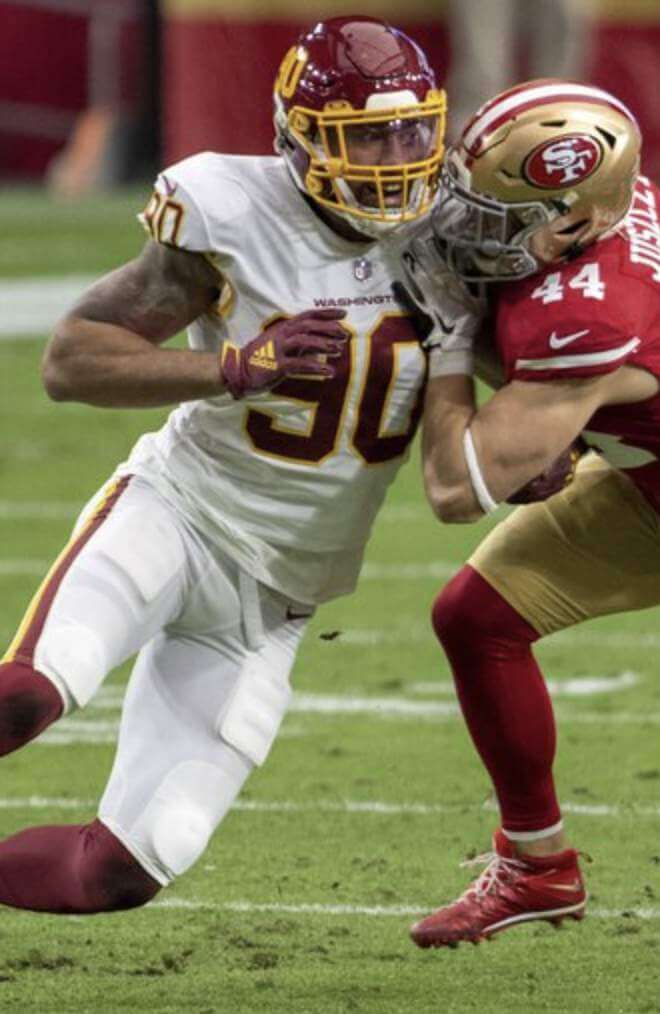
So at one time, we actually said to them, “Okay, so you say you can’t remove your name from the stadium because you have a contract to 2024” — or ’26 whenever it was — “but you can still distance yourself from the team name.” Like on their website, they could remove the R-word from their website, or remove the FedEx logo from the press conference backdrops, things like that. And they just said, “No, we really value our business relationship with the team.”
So we tried for years. And then what happened last summer, it was just sort of a miracle. You know, after all the time that we had worked on it and all the people involved. It was just amazing.
UW: Do you think it would have happened if not for the social uprising in the wake of George Floyd’s murder? Would you even have decided that last summer was the right time to send those three letters? How much of it was about using the right tactic at the right moment?
SH: Well, it was definitely the right tactic at the right moment. With corporations, there’s a cost/benefit analysis, where they keep saying no, no, no, no. But then at some point, there’s a moment where suddenly everything changes. And that’s what happened last summer. Different companies, different brands, all asking themselves where they want to be on this.
UW: I’ve heard people say, “Well, Dan Snyder only did this because of money,” or “He only did it because a few big companies have decided to be woke,” or whatever term you want to use. But of course, those big companies, and also investment firms like yours, represent millions of shareholders, and those shareholders are, you know, people who have their own thoughts and ideas. So in the big picture, was this really about financial pressure from a few big companies? Or was it about changes in the cultural state of who we are as a country and a society — changes that have filtered up through shareholders and ultimately through companies like yours, and to teams like Washington?
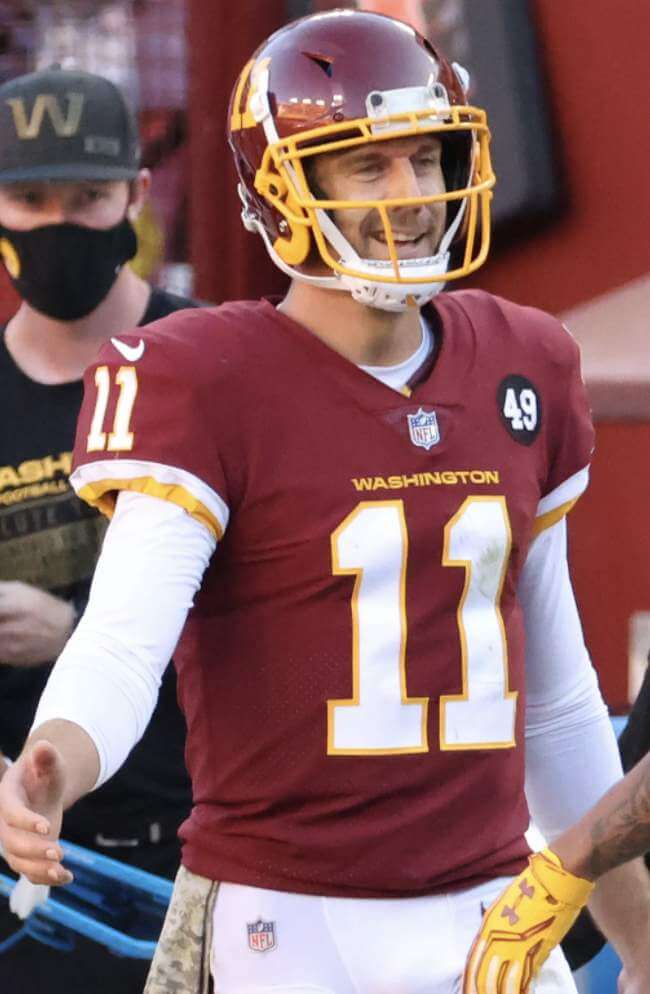
SH: I think it’s a mix of both. For years, there was also the “change the name” movement that the Oneida of New York had sponsored. Plus there are the fans in DC, and Mike Wise at The Washington Post, and the city council in Washington, saying, you know, we can’t just keep doing this. So it’s the whole mix of it.
UW: Obviously there are other teams that use Native American imagery — the Kansas City Chiefs, the Atlanta Braves, the Chicago Blackhawks. The Cleveland Indians have said they’re going to change their name. Where do you see this movement going next? And to what extent, if any, do you plan to remain involved in it?
SH: Well, the group that I’m part of definitely plans to continue, and we also want to raise the issue of other teams, yes. And probably what we would do next with the other teams is just to look at the corporate sponsors and write to them.
It’s the whole issue of self-determination. If the Seminole tribe of Florida makes an agreement with Florida State University, that’s one thing. But all these other issues, Native Americans care about how their name is used or not used, especially the issue of sacred ceremonies and practices that may seem like they’re being honored. And that’s one area that’s always been important to our group — self-determination.
UW: Are you a sports fan yourself?
SH: Definitely. Originally, it was the Oakland A’s and the San Francisco Giants and the Raiders. And after I moved to New England in the ’80s, I moved over to rooting for all the New England teams.
UW: So if you’re a sports fan, you understand the connection between a fan and a team identity. What do you say to fans who feel they’ve had something taken away from them, something they may have felt a connection to for their whole lives, or maybe even for generations within a family? What do you say to people who feel that something near and dear to them has been ripped away?
SH: I can appreciate the difficulties they’re experiencing. But at the same time, being a fan is also about the loyalty to the region and to your city, not just the team name. And also, there’s the issue of being associated with something that’s hurtful for other people. So I can’t really tell them where they should be on that. But that’s one way of looking at it.
UW: Give me a prediction — will we still have teams called the Chiefs and Braves 10 years from now, 20 years from now?
SH: I don’t think so, at least for those two teams. But I think the other area that will continue to move is the use of Indian names in branding. Like, for example, the Jeep Cherokee. And I think also just looking at movies and all of the the stereotypical ways that Native Americans have been depicted. Everyone has to be looked at as full human beings and not put in a little category because of how they look, or their name, their background. So I think that’s going to continue to evolve.
UW: Anything else you want me to know?
SH: Just that there are several people who’ve been active and involved in this over the years — it’s not just me. There are too many to name, but I think in particular Susan White of the Oneida nation, who passed away in 2018. She was the co-chair of the Investors & indigenous Peoples Working Group since we started back in 2007. And Suzanne Harjo gave our group advice and support over the years. So she’s been an inspiration for our group
When I got a text message last summer from Carla Fredericks, who was the executive director of First Peoples Worldwide at the time, saying “We did it” — I didn’t know what “it” was, and then I saw that the team was saying they’re going to change the name. You know, I just started crying, thinking about Susan and Suzanne, and all that they went through and our whole effort over the years to help bring that forward.
So that’s what I wanted to add, just to note that it’s been many people over many years who’ve worked on this issue. And we’re just happy and proud to have been part of it.
———
All very interesting. Big thanks to Steve for sharing his insights and giving us a peek behind the curtain.

Panel discussion reminder: Speaking of Native American sports issues, I’ll be participating in an online panel discussion about Native imagery in Connecticut sports tomorrow from 10am-noon Eastern. You can see the other panelists listed here, and you can register to view the event here.
If you can’t watch tomorrow, the video of the event will be archived for later viewing. I’ll post that link once it’s available.
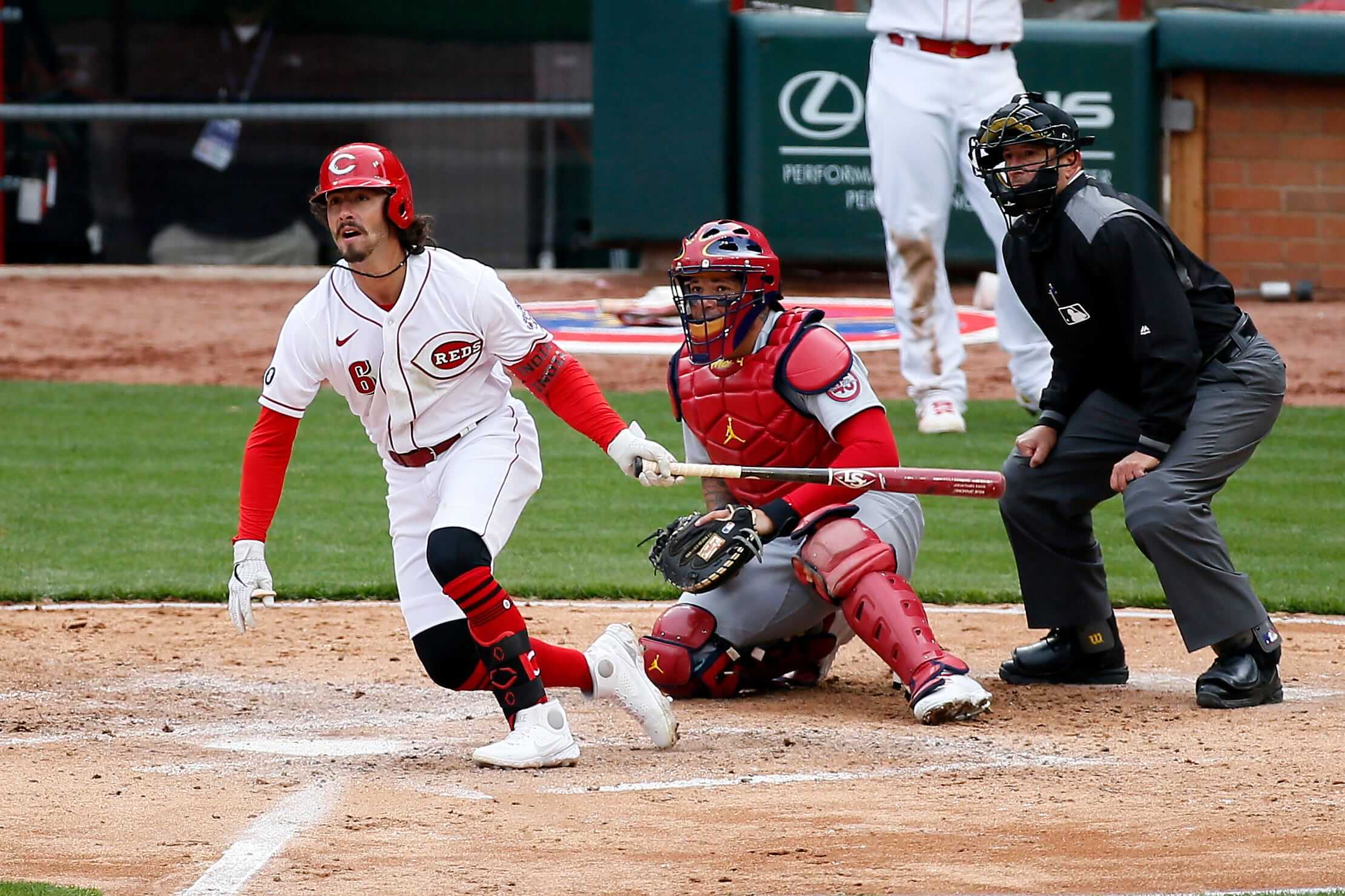
Click to enlarge
Insert obligatory “Who wears short shorts?” line here: Reds rookie second baseman Jonathan India has been setting a new standard for high cuffery. As you can see above, his pant legs stop well above the knee, and then he wears black tights and red socks. Here are a few more views:
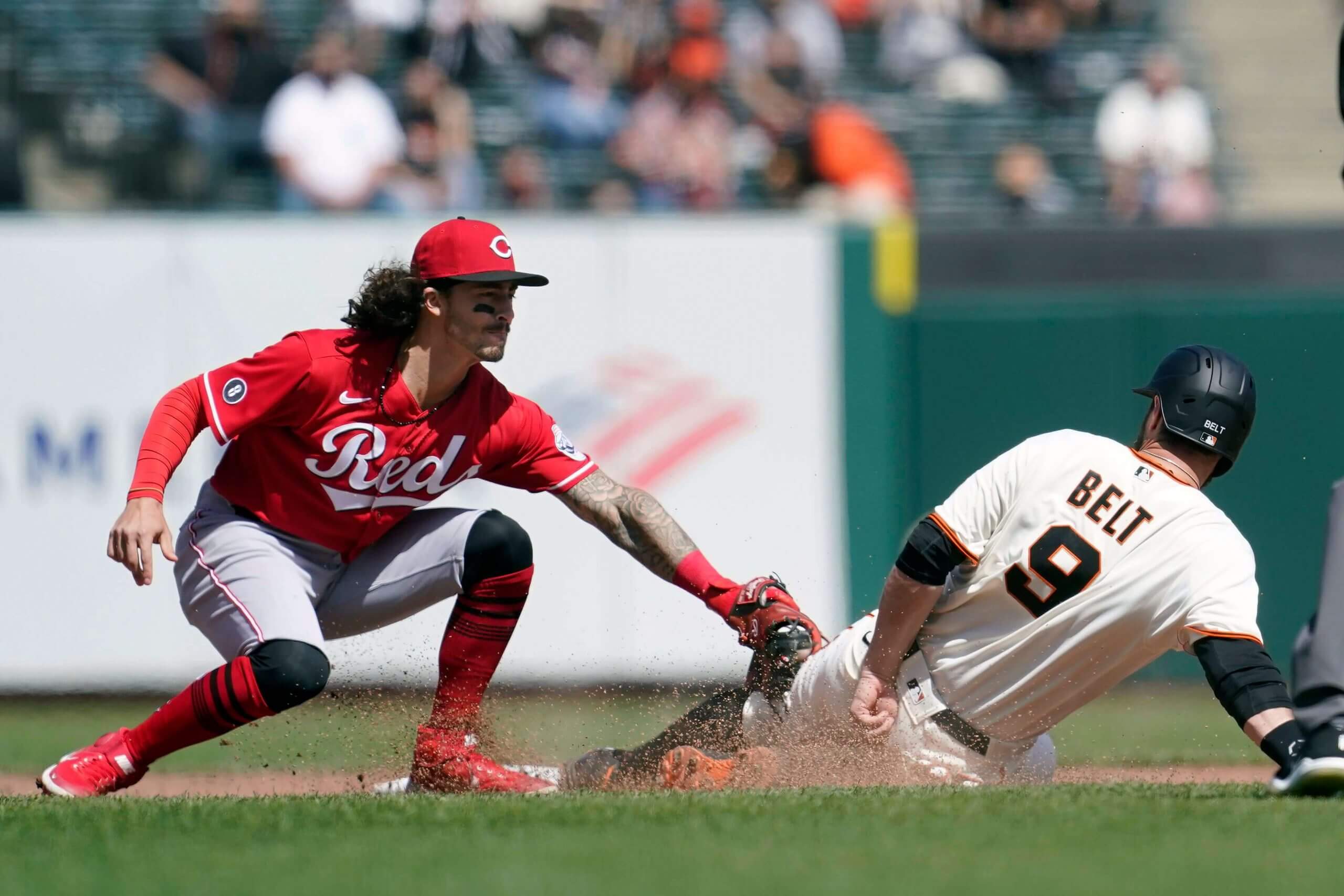
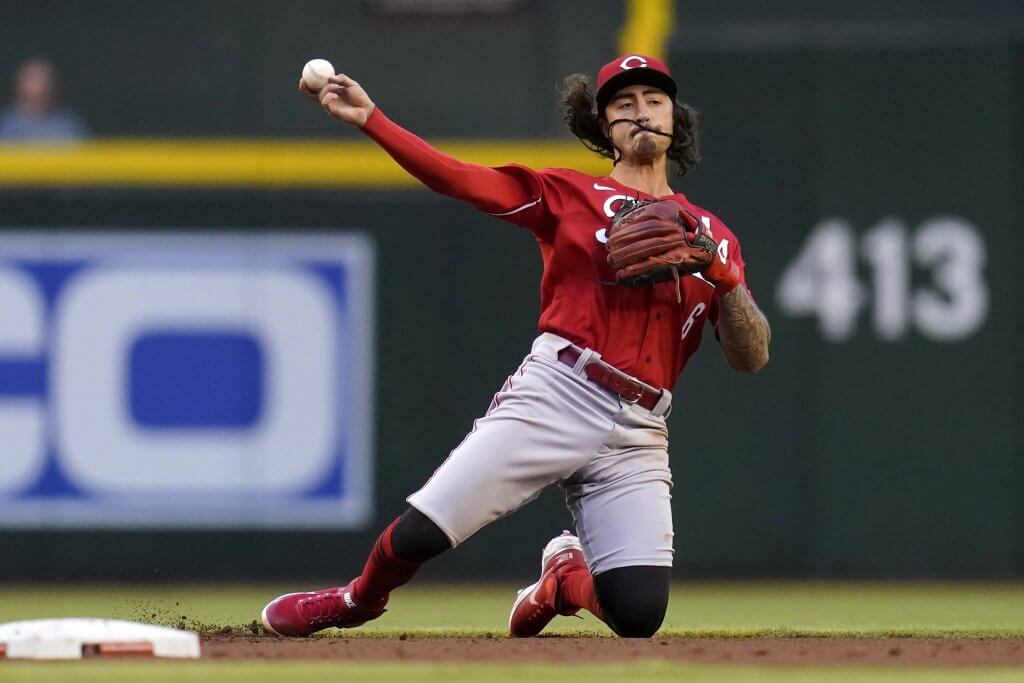
That’s certainly one way for a rookie player to stand out!
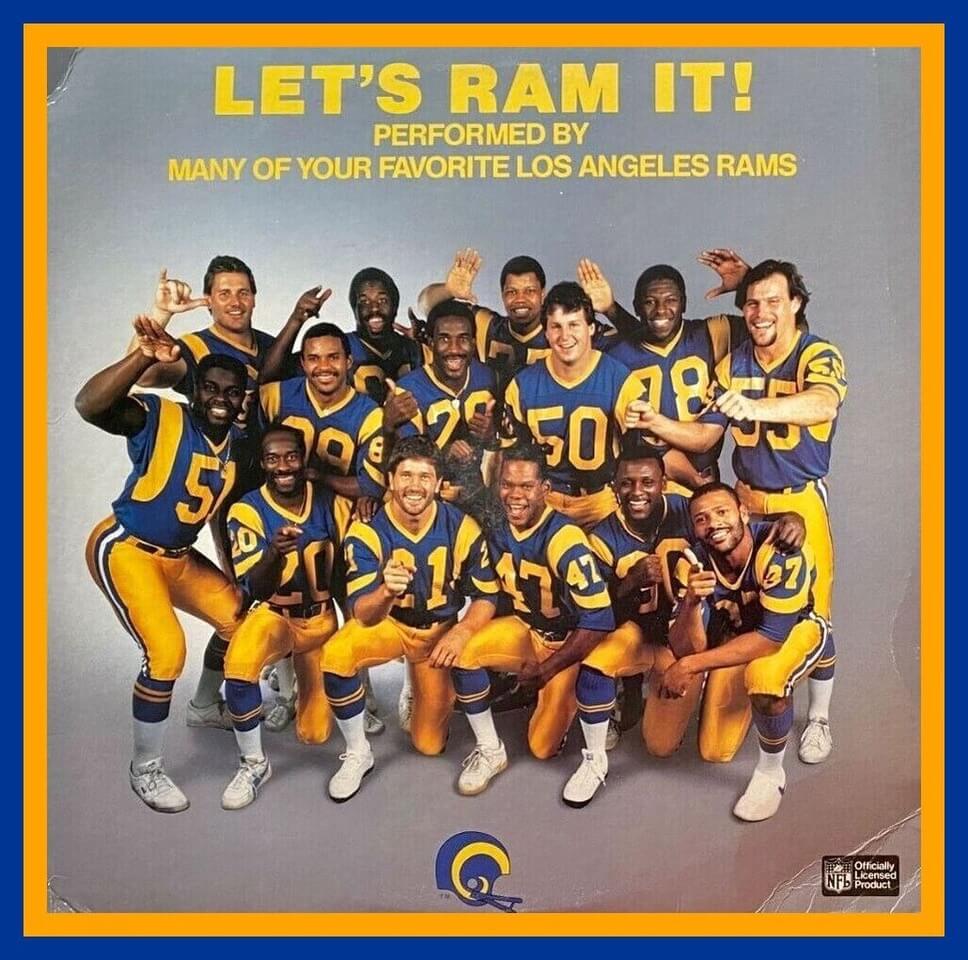
Click to enlarge
Collector’s Corner
By Brinke Guthrie
Follow @brinkeguthrie
Ram it! Do you know how to Ram it? Let’s Ram it. We know how to Ram it. We’ll be rockin’ L.A. So let’s Ram it today. Let’s Ram it.
The “L.A. Rammers” sang — and I use that word cautiously —those deep lyrics to the 1986 tune predictably titled “Let’s Ram It,” and here it is on 12″ vintage vinyl. Side A featured the Vocal Mix, and Side B was the Extended Vocal Mix and Instrumental Mix!
Don’t have a record player to play it on? No problem — hit it, guys!
Why didn’t I ever hear that on Casey Kasem’s “American Top 40”? That one scores a touchdown!
Now for the rest of this week’s picks:
• As long as we’re talking vintage vinyl records, here’s another one: This one’s called “The Phantastic Phillies” and documents the team’s 1980 World Series-winning season.
• This is the packaging wrapper for a 1950s hockey Surprise Package. It says “Terrific Hockey Prizes” and “Bubble Gum” on the front, and on the back it appears that if you mailed in “white magic letters” found inside, you could score a 5″ felt crest of your favorite team.
• Here’s a 1977 Chicago Bears “Action Team Mate” figure from Pro Sports Marketing of Concord, Cal. You can also call the plays for this guy with an Action Team Mate Playbook. (And a “misprint” version of the Playbook is available here.)
• I do believe that’s Paul’s favorite player Ken Willard on the cover of this 1975 NFL board game, Challenge Football.
• Benjamin Franklin Federal Savings & Loan was your sponsor for this nice-looking circa-1970 Portland Trail Blazers basketball bank. Made by Wyatt Dunagan and Williams of Los Angeles, which also made all those great NFL helmet banks around that same period.
• The San Francisco 49ers longtime home Candlestick Park was at one time regrettably known as “Monster Park,” as immortalized on this T-shirt.
• Speaking of Candlestick, you can see it in the background on the cover of this 1966 San Francisco Giants game program. Just a quarter!
• Teammates Keith Hernandez and Tommy Herr were featured on this 1982 Pantera’s Pizza placemat saluting the World Series champ St. Louis Cardinals.
• “Get Your Head in the Game” with this Tampa Bay Devil Rays Helmet Radio.
• Nick Volpe did his usual masterful job on this 1969 Pro Star Portrait of Dodgers pitcher Don Sutton.
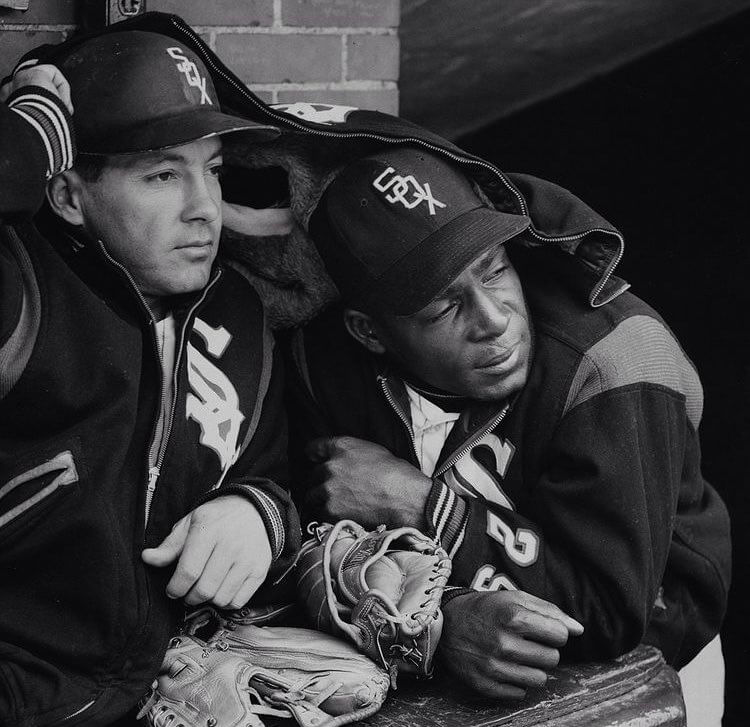
Click to enlarge
Too good for the Ticker: So much to like in this late-1950s photo of White Sox teammates Bubba Phillips and Minnie Miñoso huddling for warmth during a cold game at Comiskey. The left-sleeve number, the striped sleeve cuffs, the texture of the jacket gusset panels, the way they both have their gloves with them — magnificent!
I like the photo so much that it took me a few minutes before I realized its most uni-notable aspect: Minnie Miñoso never wore No. 29! Or maybe that’s actually a 25 on the sleeve, but he never wore that number either. He must have grabbed a teammate’s jacket. But hey, any jacket’ll do when that wind is blowing in off of Lake Michigan, right?
(Big thanks to Brian Robinson for sharing this photo with me.)
The Ticker
By Alex Hider

Baseball News: Twins SS Andrelton Simmons wore the wrong cap last night (from Lincoln Arneal). … Lots of uni details from this 1986 clip from a Yankees/Sox game. A scuffle broke out in the Bronx when a fan tried to steal Jim Rice’s cap. The video also features a random fan wearing a Los Angeles Rams jersey, and a dugout employee wearing a New York Jets shirt (from Joseph A. Bailey). … A baseball fashion exhibit is coming to the Worcester Art Museum beginning June 12. Per the article, “The exhibit offers more than 35 historic and contemporary shirts, along with vintage photographs and trading cards, fabric swatches, and logo designs.” Paul will be doing a presentation in connection with the exhibit on Aug. 12 (from Ilana Hardesty). … The Triple-A Rochester Red Wings imagined how their jerseys would look in a few other sports (from Wes and Michael Metzger). … Here’s a podcast interview with the GM of the Appalachian League’s Burlington Sock Puppets about how the club came up with its new name and logos (from @BallparkHunter). … The Madison Mallards of the Northwoods League, a college wood bat summer league, will be getting new uniforms this season (from Scott Rogers). … The Uni Lions of the Chinese Professional Baseball League have unveiled a new logo for their upcoming Tainan Nights promotion (from Jeremy Brahm). … The University of Louisville has sold the naming rights to its baseball team’s new indoor facility (from James Gilbert and Timmy Donahue). … Check out the mid-’80s uniforms for the WNBC (New York) radio station softball team, featuring none other than Howard Stern. Purple on purple! (From @NotAnotherSpor1) … A replica of Milwaukee’s old County Stadium is the latest masterpiece from @PaperStadiums (thanks to all who shared). … Former MLB pitcher CC Sabathia has a new line of clothing called Black Aces that honors Black pitchers who’ve won more than 20 games in a season (from our own Brinke Guthrie). … Molina High School in Dallas uses the Jacksonville Jaguars logo inside an outline of the state of Texas, along with a teal-to-black gradient jersey (from Chris Mycoskie). … Bit of concessions controversy out in L.A., where Dodger Dogs are being made by a new manufacturer this year (from the Tugboat Captain).

NFL News: Minnesota Vikings CB Patrick Peterson is the first player to announce he’s taking advantage of the league’s relaxed numbering system. He’ll wear No. 7 this upcoming season. … With TV numbers seemingly going out of style, Jeff Flynn sends along a photo of the enormous TV numbers the Niners wore in 1973. … … Former Bengals QB Boomer Esiason was rocking his former club’s new threads while doing his radio show yesterday (from Mike D). … Whoever put together this graphic of presumptive Jets draft pick Zach Wilson used half of the Jets’ current uni set and half of their old set, resulting in a weird hybrid jersey design (from Nick Wilwert).
College/High School Football News: The University of Maryland is renaming Cole Field House — the former basketball arena that now houses the football team’s indoor practice facility — after Darryl Hill and Billy Jones, the first Black players to integrate the school’s football and basketball teams, respectively (from Timmy Donahue). … The Valley Huskers of Chilliwack, British Columbia, have won a fan vote to determine the best amateur football logo in the Canadian Junior Football League (from Wade Heidt). … Methuen High School (Massachusetts) has named its football field in honor of a former star athlete who died of a rare form of cancer in 2009 (from Timmy Donahue). … Here are Oklahoma’s Big 12 championship rings. The two-bar facemask on the side is a surprising touch (from Sam McKinley).

Hockey News: Canucks backup goalie Arturs Silovs had a typo on his nameplate last night (from @Steve_May). … The Stars and Kings both wore LGBTQ pride-themed jerseys during pregame warm-ups last night (from Wade Heidt and Jakob Fox). … Reader Mike Engle noted in yesterday’s Ticker that this year’s puck design is slightly different from last seasons, and that the Predators are often using the old design. He notes that other teams, including the Blue Jackets, have also taken to sometimes using the old design. “Easy to not notice the difference,” he said. … Earlier this month, Brandon Weir sent along a fantastic photo of the Maple Leafs doing calisthenics in full uniform. He followed that up with an even better shot of players playing tennis — also in full uniform! … Ted Taylor notes that there is a ton of old Minnesota Wild hockey equipment currently for sale over at Pro Stock Hockey. … This classic All-Star Game poster is a handsome look at the NHL’s logos from 1974 (from Ryan Trembath). … An Islanders podcast spoke with former RW Bob Nystrom about his playing days. At about 15:45, Nystrom and hosts talk about playing hockey in glasses, which became cost-prohibitive, and how contact lenses changed the game (from @artofscorebug). … The Huntsville Havoc of the Southern Professional Hockey League will adopt two BBQ-themed identities this week — the Alabama White Sauce and the Bama Butts (from James Tiberius). … Here’s a look at the construction progress on the Islanders’ new arena (from Kary Klismet).

Basketball News: New Thunder G Charlie Brown Jr. will wear No. 44 (from numbers guru Etienne Catalan). … We’ve probably seen this before, but once more won’t hurt: Here are the 12 finalists for the Heat’s first logo design (from Matt Rashford).

Soccer News: Polish club Cracovia will auction off the jerseys they wear in Saturday’s Kraków Derby for charity (from Ed Żelaski ). … Dutch club Ajax’s third jersey has leaked, and it’s apparently a tribute to Bob Marley (from Kary Klismet). … Also from Kary: The road uniforms for Sheffield United have leaked. … New BFBS third kit for FC Tokyo (from Jeremy Brahm). … In an apparent first, last night’s Premier League match between Leicester City and Crystal Palace was paused at sundown to allow Muslim players Wesley Fofana and Cheikhou Kouyate to break their Ramadan fast (from our own Anthony Emerson). … The Scottish League Cup has a new title advertiser. “But in a twist, the ad is also the TV channel that broadcasts it,” notes our own Jamie Rathjen.

Grab Bag: Arlington County, Va., is holding online voting for a new county logo, though as William Yurasko notes, it appears to be non-binding. … The University of Arkansas has licensed a new line of tortilla chips shaped like the school’s Razorback logo (thanks to all who shared). … In a related item, there’s now a Virginia Tech-themed craft beer (from Andrew Cosentino). … A pair of sneakers designed and worn by Kanye West have sold for $1.8 million at auction (from @walbergLines and our own Brinke Guthrie). … Rancho Obi-Wan — a Star Wars-centric museum in California — is offering assorted 10th-anniversary collectibles to new members (from Jeff Wilk).

Click to enlarge

What Paul did last night: We’ve made a lot of friends over the past 400-plus days of Pandemic Porch Cocktails™ — people who have stopped to chat and shared little bits of themselves with us.
But there are also lots of people who haven’t stopped to chat but who have nonetheless become familiar to us simply by walking by so often. We don’t know their names, so we’ve come up with our own names for them. There’s the Lapper (a woman who walks several very determined-looking laps around the block each day); the Fast Smoker (a woman who walks by while taking very quick cigarette puffs, one after the other, rapid-fire, as if she’s afraid to let any of the tobacco go to waste); the Clan (two moms and their respective gaggles of very active little kids, who go by in a sort of cyclonic blur, kinda like the Tasmanian Devil, except for this one little girl who walks slowly and always gives us the stink-eye); the Racers (a very small boy and his even smaller sister, who run down the sidewalk across the street, the boy always in the lead, with their mother walking behind them); and more.
And then there’s the Blade Runner — a woman who “walks” her two large dogs by going roller-blading with them. She’s clearly an accomplished skater, but the dogs do most of the work, pulling her along as they sprint down the street.
I’ve wanted to get a photo of the Blade Runner for months, but it’s difficult because she goes by so quickly. Managed to get just a little bit of her in last night’s shot:
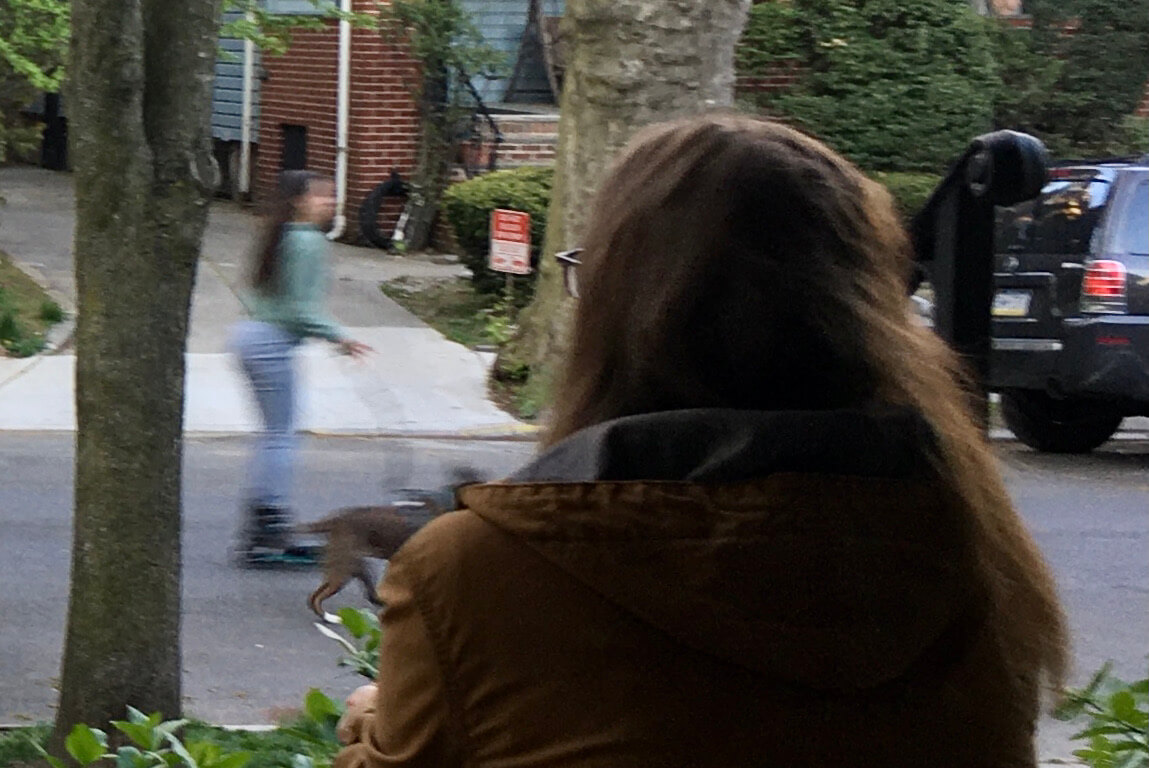
As always, you can see the full set of daily Pandemic Porch Cocktails™ photos — now more than 400 of them — here.
Our latest raffle winner is Neil Hochman, who’s won himself a membership card. Congrats to him, and thanks to Doug Steffenson for sponsoring this one. — Paul
Look closer at that Minoso/Fox photo.
The contrasting red panel on the shoulder looks to made out of a non felt material.
It looks, almost like a stretch panel.
It would make sense to have that in the shoulder for flexibility.
Yup — not uncommon for jackets in that era.
Yeah, the jackets look like they’re wool, in contrast to the shiny satin-type jackets of future decades. The red shoulder stripe looks like different flexible material, but I doubt if it stretched. You know, there’s a third jacket that Miñoso and Phillips are holding over their heads – maybe that’s Minnie’s jacket. Also, it seems like Phillips is wearing a batting helmet. The Sox logo is slightly different on each cap, and I can’t make out the red outline on the logos – but it could just be the lighting.
You can tell I loved the photo, too.
The interview with Mr.Helm and the background of ESG was enlightening.
My apologies for misspelling Steven Heim! Too early here in Seattle….
That Rays helmet is the tackiest thing I’ve ever seen.
That being said … I just hit the “Buy it now”. I love tacky old Devil Rays stuff.
It’s been 25 years since i lived in L.A., but still I cannot hear the words “Dodger Dog” or “Farmer John” without hearing it in Vin Scully’s voice.
I know a Zappa song that has “Ram it” in the lyrics.
Me too.
In the White Sox photo, great BTW, it looks like Phillips is actually wearing a batter’s helmet…thus the scuffed brim.
Good call. I’ve removed that reference.
Thanks to Doug Steffenson for sponsoring the membership card raffle. Believing my design selection will be new to the UniWatch membership card design roll.
All of the thanks go to Paul and his team for making it all possible. I’ll be interested to see your card in the membership gallery soon. Just got my new card in the mail and I’m very pleased with the final version.
So basically a bunch of oligarchs try to control everything, including names of our football teams, and we celebrate that? Don’t get me wrong, I support Washington dropping its old nickname. There is a bigger issue at play, though. We now have a handful of corporations, social media companies and financial firms essentially running a parallel government and trying to dictate cultural norms and policies.
Count me out on thinking this is a positive.
1) Actually, nobody “celebrate[d]” anything. I simply presented the story because it’s interesting. Your mileage may vary and all that.
2) Calling this a “parallel government” is inflammatory and demonstrably false. Please don’t do that again on my website.
3) As I have written many times, I agree that corporate culture has too large a role in American life. But as clearly noted in the interview (and in other analyses I’ve presented over the past year), this isn’t just about corporations — it’s about their shareholders and all the rest of us. You’re completely ignoring the fact that these companies are *reflecting* where we are as a society, not *dictating* it.
4) Companies make decisions all the time about which business partners are or aren’t appropriate to partner with (just like you and I make decisions all the time about how we spend our money). Nothing nefarious about it — it’s a straightforward choice of how and where to spend money and other resources. Simple.
“You’re completely ignoring the fact that these companies are *reflecting* where we are as a society, not *dictating* it.”
I am going to disagree here. They are reflecting what the LOUDEST elements are saying. I really don’t think the majority of people are passionate enough about this to care either way. Had the ownership not caved, they would still have fans. Another company would have stepped forward to sponsor them. As a Cowboys fan, I am not heartbroken for them, mind you, but there is a market for their team and brand.
From a corporate perspective, who are scared to death of the cancel culture tactics, I can understand this. And, to some degree, I have to give the cancel culture practitioners, as bad as their tactics are for a cohesive country where people can coexist and disagree, have diligently worked to amplify their voices.
The solution is clear. Those who are passionate against this type of tactic, have to get equally loud. The masses still won’t care, but if Corporate America realizes that the ends counterbalance and the rest are not invested, the ability of radical activists to run roughshod over this country will end. Those who support plurality of opinion have to adopt some of the cancel culture tactics, a vaccine if you will, as an antidote to the toxicity that segment of society brings on this country. This runs against the nature of these folks who don’t practice groupthink in general and are typically far more independent minded. But it must be done if we are to save this country for reason and civility and truth. Many are waking up, but what will be the tipping point to push enough people into action to be an effective counterbalance?
Ah, yes — the great silent majority.
Always a good fallback position whenever you’re on the losing side of something.
You obviously did not read what I wrote. I stated neither side was a “majority.” But it’s disingenuous to act as if everyone agrees with the wokes. They don’t. Some mildly agree, some mildly disagree, and some are the mirror opposite who would loudly disagree. We need them to figure out how to coalescence and amplify their small voice just as the wokes have. So no, this has nothing to do with the “great silent majority” argument. Was that just an attempt to dismiss that not everyone agrees with you? That a big part of my entire point against those who support this type of thing.
it’s disingenuous to act as if everyone agrees with the wokes. They don’t.
Nobody made that claim, actually. And yes, of course I realize that not everyone agrees.
And when you begin your argument by saying that “the LOUDEST voices” determine what happens, that is pretty much the literal definition of the silent majority argument, whether you specifically invoke it as such or not. It’s a way of dismissing a point of view based on something irrelevant (in this case, how “loud” it is, whatever that even means) instead of actually engaging with the actual point of view being expressed.
This is silly. Let’s please move on. Thanks.
I mean the alternative in most cases is the government having this power instead of the ostensibly free market, which is a billion times worse.
Interesting interview.
You know what would prevent Andrelton Simmons from wearing the wrong hat? Not having more than 1 hat. Seemed to work fine for teams for decades before big business turned pro sports into a fashion show and merchandising expo.
Or he could, you know, pay attention to what the rest of the team was wearing. Not that difficult.
Having multiple hats is a good and fun thing. Having multiple hats that are so similar to one another that they can easily be confused between themselves (looking at you, Pirates) is a very much not good and fun thing.
“Darryl Hill and Billy Jones, the first Black players to integrate the school’s basketball and football teams, respectively”.
They were both also the first black players in ACC history, before North Carolina and Duke.
Hill was recruited by Maryland assistant coach Lee Corso.
Jones was a starter when my Dad took me to my first of many Maryland basketball games.
I really appreciate the work these people have been putting in for years for some progress! Thanks for sharing the story.
Until we get the other major offenders the Chiefs, Braves, and Texas Rangers to change their names as well the war is not won!
What’s wrong with the rangers name in Texas
I think it’s the putative association with white supremacists in the 19th century. The book link released last year made the topic prominent again.
It’s been brought up that the original Texas Rangers (law enforcement agency) had a really nasty history of racist violence, including multiple massacres directed against Tejanos, Mexicans, Indigenous, and Black Americans.
I think it’s safe to assume the MLB Texas Rangers will change their identity when the law enforcement group of the same name does.
I’m guessing the MLB Rangers will change their identity when the law enforcement group of the same name opts to change it.
(You can delete one of these if you like)
Why stop there, what about the New York Rangers? They were named after the same Texas Rangers. “New York City Hockey Team”?
John,
Curious: following your line of thinking, if the four franchises you mentioned did change their names, are there any other teams who you’d like to see change their names as well?
Conversely, are there any team names others discuss to change that you would say leave them be?
Personally, I am of the opinion to leave them all be, but am interested in hearing your perspective.
Thanks,
-C.
At first just the offensive ones that use direct imagery like the Chiefs and Braves and ones that represent organizations which committed genocide like the Texas Rangers, but I understand your question.
Maybe something like the Padres if it is considered to belittle religion? It’s hard to say.
There is a sliding scale as we learn as a people what offends others. At some point even animal names may be offensive, or at least ones that might be endangered. Or as we learn more about animals and their feelings maybe cartoon depictions will be offensive at some point.
I am just relieved to know people much smarter and dedicated than me are working to help the sports world become better.
A team like the Chiefs is not the same as a derogatory name like Washington had. I think they could keep the name somehow, but get rid of the Native American imagery. However, my best case scenario is they rebrand to the Kansas City Wolves because the mascot is KC Wolf. Easy enough, little change, and everyone is happy.
I’ve been born and raised in KC, just for transparency.
Here’s a 1977 Chicago Bears “Action Team Mate” figure
I got rid of my Steelers Action Team Mate a long time ago, but I still have the number stickers that came with it. Actually trying to incorporate some of them into a DIY project I’m working on currently.
Looking forward to that DIY!
And note to self, look for Team Mates at garage and yard sales based on the prices some of those are going for!
I’m thinking that with the NFL’s relaxed numbering system, QBs are going to have a much harder time getting a number they want. Being a USC and Cardinals fan, I remember when Matt Leinart couldn’t get his college number 11 because Larry Fitzgerald had it. Now with so many more position groups being able to select single digit up to 19, there could be a shortage of desirable numbers. And it won’t be ust incoming college QBs who will have a problem selecting numbers. Every free agent or traded QB is going to find ess numbers to select from, with it more likely than before that their previous number won’t be available.
Want versus available. Two different decisions. I think at first, while a QB may not find the number they truly want, they’ll find something suitable in the 1-19 range.
However, as time rolls on, you may need to extend the QB’s range to cover the 20s just in case.
It’s like that in the CFL, where 1-19 can be worn by many players. Quarterbacks kind of get what they get, especially if they are the 3rd stringer. I think teams might leave one or two numbers open in that range in case they need to bring someone in.
Good point. Since it appears that single-digit jersey numbers are particularly desirable, and that WRs seem to prefer 11-19 instead of numbers in the 80’s, this rule change might become a headache for teams having to decide which players get the numbers they want. Remember that most teams will have three QB’s as well as a punter and kicker who have to wear 1-19, and it’s very likely that the demand for the remaining 14 numbers will exceed the supply.
How have I never heard that Rams song before?!
As is often the case, the lead was going to be something else. Then at the last minute I found this, and debated briefly on whether to use it. But, the old ‘it’s so bad it’s good’ argument won.
Terrific interview with Mr. Heim today – thanks for sharing this, Paul. I have ambiguous feelings about shareholder activism. I mean, often the phenomenon is engaged in virtuous causes and, from time to time, achieves virtuous results. But! Two buts, really. First, in the instances of virtuous shareholder activism, it often reflects the failure of democratically accountable state power to protect or advance public goods. I know plenty of people believe that it’s better for power to be exercised by private actors rather than by the state, but I disagree profoundly. In a democratic republic, the state answers to me; corporations do not. So I much prefer power to be exercised by people who must seek my permission and approval at regular intervals via elections. Second, shareholder activism sometimes happens on behalf of nefarious or socially destructive ends that tend to advance the oligarchic and even monopolistic power of private capital over the broader community. Sometimes investor activism calls for changing brand names to be more respectful of minorities; sometimes investor activism calls for slashing payrolls and exporting jobs to foreign countries where labor is both cheaper and more vulnerable to exploitation and abuse.
I don’t mean to take away from the credit and praise due to Heims and those his firm has partnered with; a virtuous outcome is always to be celebrated. But I’m also somewhat troubled by the existence of the powerful weapon Heims et al are using here; the weapon they wield for good is also available to be wielded for evil, and it frequently is. Nor do I mean to argue that shareholders ought to sit down and shut up; given the ubiquity of large limited-liability shareholder-owned corporations, shareholder activism is better than the alternative. I guess I sort of wish different structures of ownership and liability were more common. Anyway, thanks again for today’s interview – really terrific bit of journalism. I’d love to hear a five-minute version of this in audio form on “Marketplace”!
Just put the stripe back on the WFT helmet and remove those post-it note numbers.
The numbers should be white outlined in gold, and with helmet numbers they should remove the sleeve numbers allowing more room for stripes. Then you have a pretty decent looking uniform.
Add yellow pants to the mix and there you go!
I like the stripeless helmet.
On Saturday, Phil posted my WFT helmet; it totally slaps
The Zach-Wilson-As-A-Jet hybrid uniform design got me thinking about the ’78 Jets pre-season set:
link
I was at that Red Sox/Yankees Game! The bedlam was infectious that day. Saw at least three fist fights on the way out of the Stadium, including one guy lunged at another and they flew out one of the exits. It was insane! Those were the good old days of Yankees/Red Sox!
“Ted Taylor notes that there is a ton of old Minnesota Wild hockey equipment currently for sale over at Pro Stock Hockey.”
All of those items are from this year’s Retro Reverse uniforms sets, which would pair beautifully with Uni-Watch hockey jerseys!
I watched the whole Cleveland/Minnesota game and never noticed Simmons’ cap was different. Some uni watcher I am!
Wish this news had come out before your interview: Olympic uniform manufacturer Anta announces it will continue to use cotton derived from the Xinjiang province in China (produced by ethnic slaves in concentration camps.)
I would have loved to know whether Mr. Heim saw these gross human rights violations as more worth fighting for than a team nickname. Would he pressure teams and/or countries to disavow Anta’s products? Would he call for boycotting the Games? Would he pressure all the Olympic sponsors just as he pressured WFT’s sponsors?
Yes, they’re two separate issues. But once you champion yourself as a proponent of shareholder advocacy, it makes sense to ask exactly which issues are worthy of advocation and which issues you don’t feel are worth fighting for. And why.
link
I half agree with you in the sense that quite often a corporation might take a side in a symbolic issue such as this one in order to distract from more substantive problems that they are a part of.
On the other hand, I’ve never quite thought it was fair when somebody is championing a cause to “hey, how come you aren’t also working on this cause?” No one person or group can take on every issue…
There are so many worthy causes one can become paralyzed trying to decide which one deserves your efforts. It’s best to focus on the on that has meaning to you.
The Minnesota Wild items on Pro Stock Hockey aren’t old, they’re from their Reverse Retro uniform
Paul,
Thank you for today’s lede. Great insight on all of this. I can’t believe that it goes back so far. Also great to hear that there are socially and environmentally friendly investment firms out there.